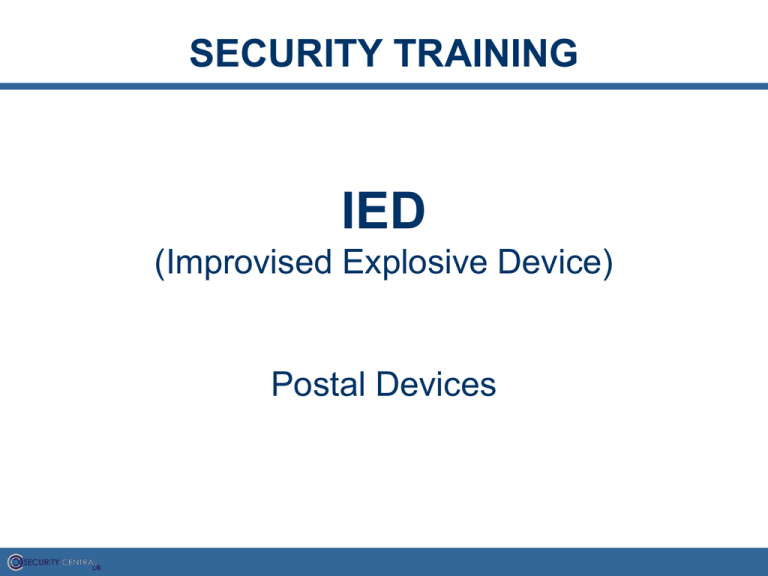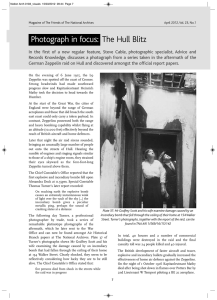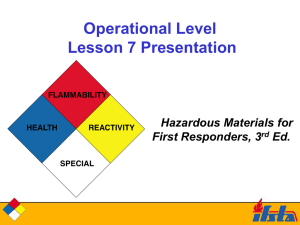IED (Improvised Explosive Device)
advertisement

SECURITY TRAINING IED (Improvised Explosive Device) Postal Devices Aims & Objectives Aims: The aim of this training session is to educate staff on the various IED/Incendiary postal devices that could pose a threat to your working environment and how to manage the immediate situation Objectives: Understand the four C’s Learn the different ‘types’ of postal devices Teach you the ‘Tell-Tale’ signs of a possible suspect package Establish what actions you need to take IED - Typical Explosive Compounds Typical Compounds & Detonators: Plastic Explosive (or the obsolete term plastique) is a specialised form of explosive material. It is soft and hand malleable and may have the added benefit of being usable over a wider temperature range than pure explosive - (often made of a military used material called semtex or a slightly less effective and combustive material called C-4). Some terrorist groups have also used plastic explosives, especially Semtex and C-4. In October 2000, terrorists used C-4 to attack the U.S.S. Cole, killing 17 sailors[2] In 1996, terrorists used C4 to blow up the Khobar Towers U.S. military housing complex in Saudi Arabia. Nitro-glycerine (NG), is a heavy, colourless, oily, explosive liquid obtained by nitrating glycerol. Since the 1860s, it has been used as an active ingredient in the manufacture of explosives, specifically dynamite, and as such is employed in the construction and demolition industries. Similarly, since the 1880s, it has been used by the military as an active ingredient A Detonator is a device used to trigger an explosive device. Detonators can be chemically, mechanically, or electrically initiated, the latter two being the most common. Explosive Ordnance Devices or EOD (hand grenades, naval mines etc.) generally use mechanical detonators. IED - Typical Components IED - Dealing with a Suspect Device - Video VIDEO IED - 4 C’s 01 - Typical Parcel Device Indicators 01 - Typical Parcel Device Indicators Oil/Grease like stains and/or finger marks Mis-spelt name/address and/or missing postcode etc Excessive postage Strange odours (especially marzipan,Almond or petrol) Foil underskin Possibly strong minty or perfume smell in an attempt to hide true fragrance Protruding wires Uneven weight heavy on one side Heavily sealed (lots of tape etc) 02 - Letter Bomb (Musical Greeting Card) 02 - Letter Bomb (Musical Greeting Card) Origination of letter Excessive postage Incomplete post code Not addressed to any particular person within the organisation Heavy and Bumpy feel 02 - Letter Bomb (Musical Greeting Card) Battery/Power Source Trigger Detonator Plastic Explosives & Nails 03 - Letter Bomb (Foil Contact Strip) 03 - Letter Bomb (Foil Contact Strip) Excessive postage General feel of letter Marked Private 03 - Letter Bomb (Foil Contact Strip) Battery/Power Source Nitro-Glycerine Explosive Detonator - this would normally be a model rocket fuse Contacts & Trigger 03 - Letter Bomb (Foil Contact Strip) Contacts & Trigger Bottom section would be sealed into the envelope so not to move 04 - Incendiary Device 04 - Incendiary Device Marked ‘Private and Personal’ Possibly a smell of petrol or chemical General Feel of package 04 - Incendiary Device Back view - top section slightly pulled out 04 - Incendiary Device Larger section would be secured inside as not to move, allowing the adjoining card to be pulled therefore sparking the matches 05 - Letter (Razor Blades) Unless viewed under an x-ray machine this envelope would not be seen as suspicious 05 - Letter (Razor Blades) Razor Blades Designed to cause lacerations to fingers as they are run through the edge to open. Blades can also be contaminated, so causing illness as well as cuts 05 - Letter (Razor Blades) 06 - Letter Bomb (Mini Micro Switch) Do not bend Sticker Lumpy Feel Weight Unless viewed under an x-ray machine this envelope would not be seen as suspicious. The only possible indicators would be ‘do not bend’ and ‘Overseas Address’ however these are not conclusive - envelope may feel bumpy 06 - Letter Bomb (Mini Micro Switch) Trigger (Switch) Detonator Plastic Explosives Activation switch (on/off) Battery/Power Source 07 - Postal Device (Mechanical ‘Mardi-Gra’ Campaign) 07 - Postal Device (Mechanical ‘Mardi-Gra’ Campaign) Just addressed to the manger Is the package unusual to the nature of the business? If the item can be identified, does it appear to match that description? 07 - Postal Device (Mechanical ‘Mardi-Gra’ Campaign) Spring Live shot gun shell Door bolt Spring is pulled back and held why the lid is closed, upon opening the bolt is released under the spring tension hitting and firing the shot gun shell 08 - Postal Device (Light Sensor) 08 - Postal Device (Light Sensor) Do Not X-Ray Sign Just addressed to the manger Is the package unusual to the nature of the business? If the item can be identified, does it appear to match that description? Weight Comments on package that may raise concern 08 - Postal Device (Light Sensor) Detonator Trigger (Sensor) Plastic Explosives Activation switch (on/off) 09 - Tube Bomb (Stage Fireworks) 09 - Tube Bomb (Stage Fireworks) Not addressed to any one person Postage costs One end sealed more than the other 09 - Tube Bomb (Stage Fireworks) Trigger (Sensor) Buzzer is just for the purpose of the imitation device Theatrical Maroons (Large Stage Fireworks that contain gunpowder) Activation switch (on/off) Actions ‘Upon Discovering a Suspect Device’ What do you do when you suspect a parcel or post item? •Don’t panic! - Try to remember that postal devices are usually triggered upon opening and would have been processed through the Royal Mail and transported on delivery vans etc - Time is not normally a matter of concern. •Place the item in the ‘BOMB BIN’ (picture for illustration purposes only) •Leave the post room, securing the door behind you and make your way to the nearest telephone and call your security department or pre-notified person. •It is important to maintain calm during this situation, the matter in hand should not be advised to anyone else other than the nominated contact person in these situations. •The decision to not evacuate, partially evacuate or commence a full evacuation will be determined by considering a number of factors including the perceived level of risk from the information gained from the immediate threat. (The suspect item, location, circumstances etc) •These decisions will normally be made by senior management within your organisation and will be notified. Aims & Objectives Aims: The aim of this training session is to educate staff on the various IED/Incendiary postal devices that could pose a threat to your working environment and how to manage the immediate situation Objectives: Understand the four C’s Learn the different ‘types’ of postal devices Teach you the ‘Tell-Tale’ signs of a possible suspect package Establish what actions you need to take End Thank you: Following a 10 minute break period you will be asked to complete a short test paper based on the training session you have received.















